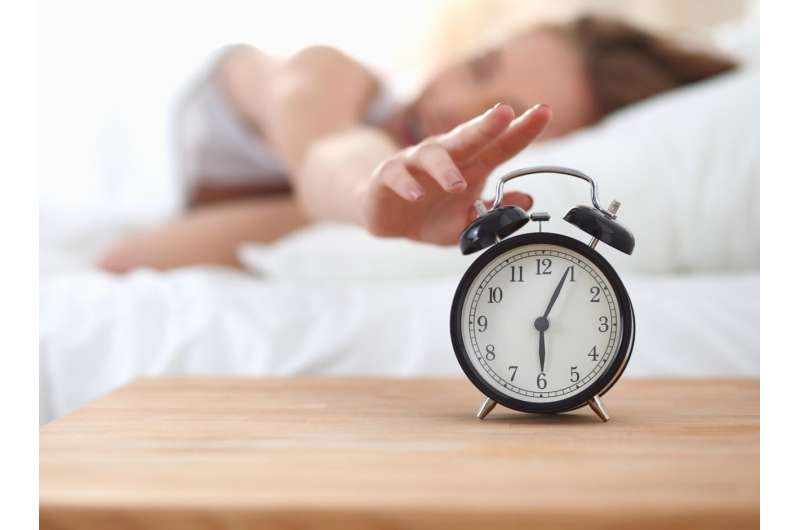This article has been reviewed according to Science X's editorial process and policies. Editors have highlighted the following attributes while ensuring the content's credibility:
fact-checked
reputable news agency
proofread
It's that time again: Tips on adjusting to the start of Daylight Saving Time

When the clocks spring forward or fall back, many folks will find themselves struggling to adjust.
The transition to Daylight Saving Time can be tough on people, both mentally and physically.
Research has found that people "springing forward" have an increased short-term risk of heart attacks, stroke, traffic accidents, ER visits and mood problems.
A lack of sleep triggered by the time change can also affect thinking, decision-making and productivity, experts say.
This is because the switch alters your normal pattern of daylight exposure and throws off your body's circadian rhythm, the internal clock that helps control sleep and other bodily functions, the Sleep Foundation says.
Luckily, some simple routines can help a person better cope with the transition, experts say.
Daylight Saving Time is a one-hour clock adjustment that is observed by most of the United States. It begins on the second Sunday in March and ends on the first Sunday in November.
Then, from November to March, clocks "fall back" by one hour to standard time.
The Autumn transition to standard time tends to be associated with fewer health problems, but having an extra hour of sleep will do little to help people suffering from long-term problems with sleep deprivation, the Sleep Foundation says.
People can prepare for the start of Daylight Saving Time by:
Gradually adjusting their sleep schedule in the week before the time change
The American Academy of Sleep Medicine recommends going to bed about 15 to 20 minutes earlier each day as the transition approaches. The timing of other routine activities like meals and exercise also can be gradually adjusted forward. These early changes can help people acclimate prior to the actual transition.
Sleep well beforehand
Folks also can get a little extra sleep beforehand, essentially building up a "sleep bank" to better cope with the switch. Studies have shown that banking sleep in expectation of short periods of reduced sleep can decrease the brain fog that comes with a shortage of good rest.
That reserve of extra sleep also might make it easier to stay awake during the day and resist dozing off.
Try relaxation techniques
Relaxation techniques like deep breathing exercises or mindfulness meditation can calm the mind and body and make it easier to slip off to sleep, particularly if a person is moving up their sleep time in preparation for Daylight Saving Time.
Relaxation methods also can help folks get back to sleep if they've woken in the middle of the night due to the time change.
Set clocks to the new time before bed
Even though the time change doesn't officially start until 2 a.m. Sunday, setting watches and household clocks before bedtime can help people hit the ground running and avoid any scheduling mishaps.
Many cell phones and other devices automatically switch between Daylight Saving Time and standard time. People can check to see if those settings are active, or simply adjust them before bed.
Prioritize daylight exposure
Daylight drives circadian rhythm, so people should find time to get out in the sun on the days following the transition to Daylight Saving Time. That can help the body's internal clock transition to the time change.
Natural light helps the circadian rhythm even on cloudy days, researchers said. Folks should plan to go outside in the morning and get some sun exposure, or at least open their curtains and sit near a window to take in a meaningful dose of natural light.
Prepare for sleep disruptions
It's a good idea to take precautions in case the time switch interferes with sleep. People should try to keep their agenda simple on the Sunday and Monday after the time shift, scheduling important meetings or events for later in the week after they've had time to adjust. It also might be a good idea to avoid long drives, lest drowsy driving increase the risk of a traffic accident.
Practice good sleep hygiene
Year-round good sleep habits can aid the transition to and from Daylight Saving Time. Folks can help their sleep by maintaining a fixed sleep schedule on both weekdays and weekends; limiting or avoiding caffeine or alcohol in the afternoon and evening; going "device-free" at least a half-hour before bed; blocking out unwanted noise and light in the bedroom; using a sleep mask or ear plugs; and choosing a supportive mattress and comfortable bedding.
Eat a healthy diet
Balanced diets with lots of fruits and vegetables tend to provide the nutrients needed by the body, and are associated with better sleep. People also should eat dinner at least a few hours prior to bed, limit consumption of heavy and spicy foods at dinner time and avoid caffeinated beverages.
Take a short nap if necessary
People who are particularly groggy after the time switch might want to take a quick nap. Keep a nap under 30 minutes, to boost alertness while also avoiding the grogginess that comes with napping longer.
Naps are best in the early afternoon, when people are most likely to feel drowsy. Naps too late in the afternoon or evening can make it harder to fall asleep at night, hampering the transition of a person's sleep schedule.
Copyright © 2024 HealthDay. All rights reserved.



















